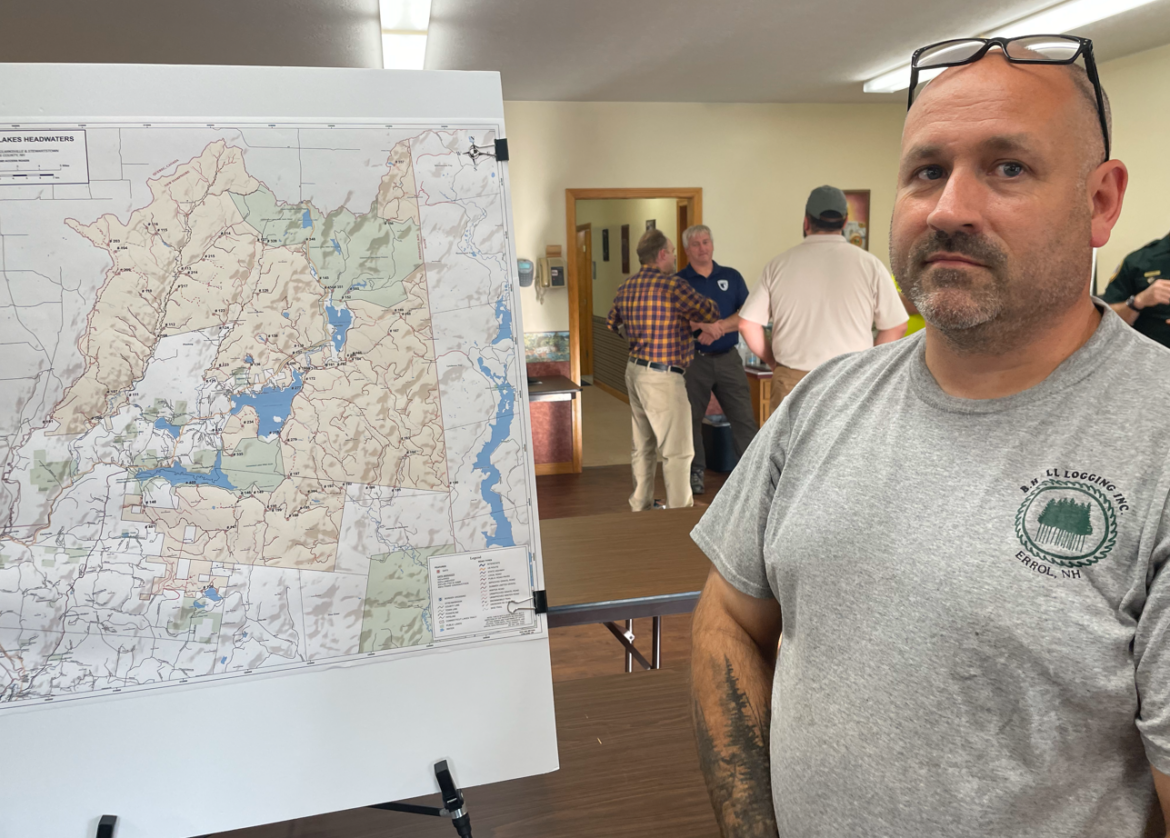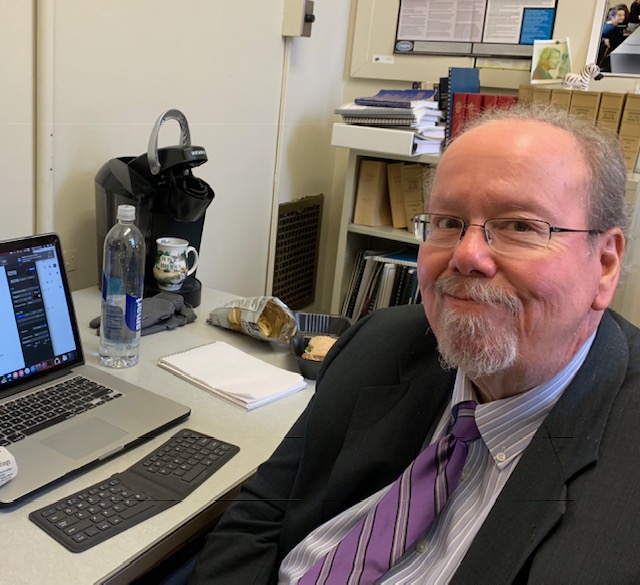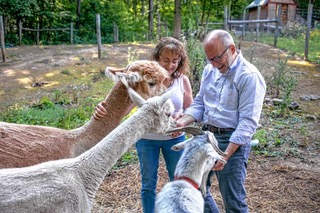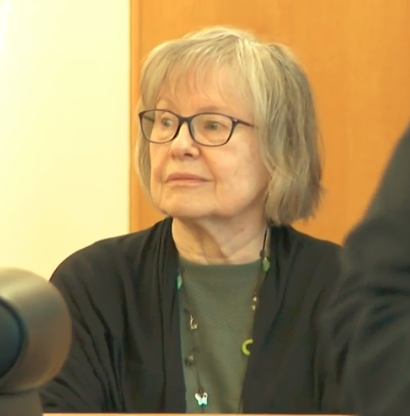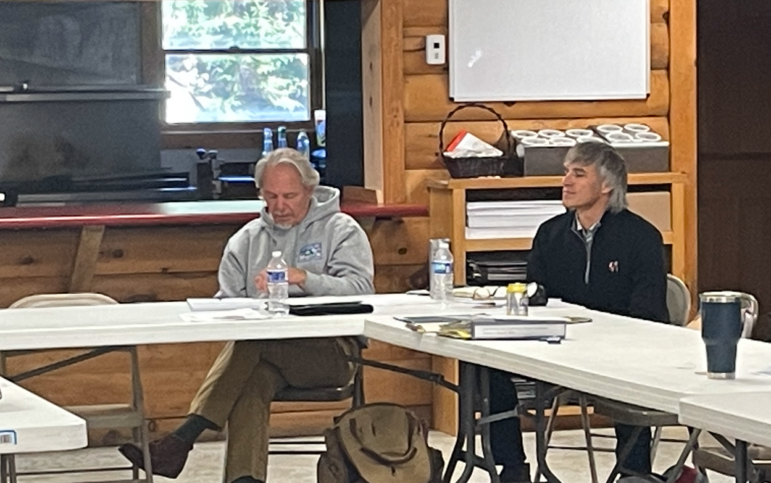
By PAULA TRACY, InDepthNH.org
PITTSBURG – Eric Hall said he was the last logger out of the 146,500-acre Connecticut Lakes Headwaters tract.
Hall stood in front of a map at the Pittsburg Fire Station Tuesday evening and shook his head, considering the new owner’s – Bluesource Sustainable Forest Co. – plans to reduce by 50 percent the logging operations on the largest tract of land at the northern tip of the state.
Conserved 20 years ago with the help of the state, federal government and private citizens who paid for a $46 million conservation easement to maintain logging and recreation when the International Paper Company offered it up for sale, the forest is now silent.
While snowmobiling, hunting and traditional recreation uses will continue, Hall said he worries about the future of logging and a way of life, beginning for the region in the world of carbon credits which value tree preservation rather than tree cutting.
“My family has been in the logging business for 50 years. It’s all we’ve known. It’s all we have,” Hall said.
He said he thinks logging and carbon credits could coexist and that the land may not be a perfect fit for the new owners.
He and others attending the information session were asked to fill out a state survey of what he would like to see for the future on the land. A second meeting was held Wednesday at Pittsburg Ridge Runners’ headquarters.
Hall wants to see it logged, as it has been for centuries.
In 2003, International Paper Company offered 171,500 acres of industrial timber land for sale, sending shock waves through the region.
With the help of local citizens groups, state and federal leaders it was determined that about 25,000 acres should be sold to state Fish and Game for habitat management and the remaining 146,500 acres sold with an easement protecting it for logging and recreation.
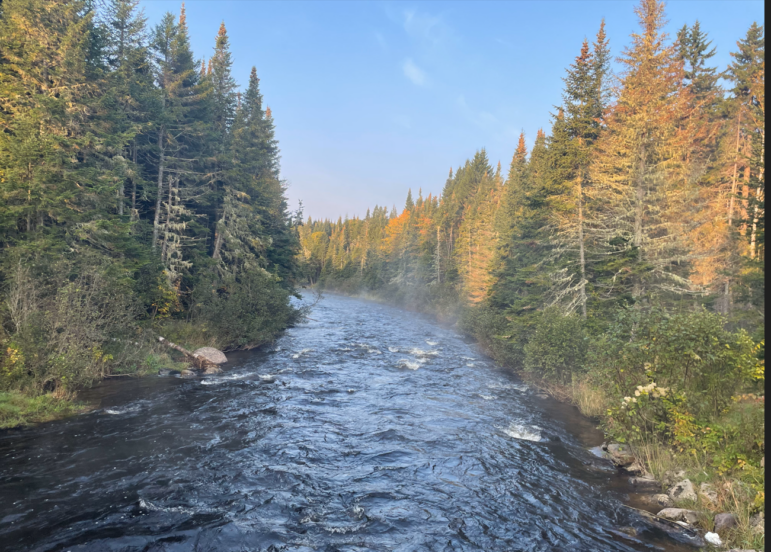
Above, The Connecticut River near its headwaters on the Magalloway Road is part of the 146,500-acre tract conserved for logging and recreation 20 years ago and now the subject of change as a new owner pursues carbon credits. Paula Tracy photo
The land was first purchased by Lyme Timber Company and logged in a sustainable fashion and then in about 2009 was sold to the Forestland Group which merged with Bluesource Sustainable Forest Company, (BSFC) a subsidiary of Anew Climate last October. It owns 1.7 million acres in the Eastern United States on 27 different tracts.
The company’s mission is to not cut as much in the future, as its corporate goal is to leave the trees standing and sell the stand for carbon credits.
When the easement was crafted for public benefit, there was no such market for climate credits, said Charles Levesque, a member of the citizens committee and a drafter of the original easement.
But in 2013, without any public input or needed discussion, the Forestland Group signed up almost all the acreage on the California carbon credit compliance market for the next 100 years.

Above, citizens and members of the Connecticut Lakes Headwaters advisory committee hear from the new owner of the 146,500 acres Wednesday at the Pittsburg Ridge Runners headquarters. Paula Tracy photo
WHAT IS A CARBON CREDIT?
Companies that emit carbon in California are required by state law to either reduce their carbon emissions and/or purchase carbon credits, where the owner leaves the land to grow and capture carbon rather than cut it.
That market has grown and become more lucrative in recent years than logging and a separate and voluntary market for carbon credits exists but is unregulated, for companies that are trying to reduce their carbon footprint to zero. This land in New Hampshire is not part of the voluntary market but in the compliance market.
The carbon credit runs with the property to the next owners through its term, or there is a heavy penalty to pay, BSFC officials confirm, including repayment of the lump sum amount paid in 2013.
The amount paid nor annual revenue has not been disclosed by the owners. BSFC also receives regular payments to keep the tract in compliance which has to be monitored and verified.
But there is room for some logging on the land, which has never been cut as fast as it grows, officials said.
Currently, the value of the market for logs is lower than the carbon market due to the economy, interest rates, a lack of building and other factors, but it can change quickly. For investors in land, carbon credits provide a revenue alternative to logging and keep it from being developed.
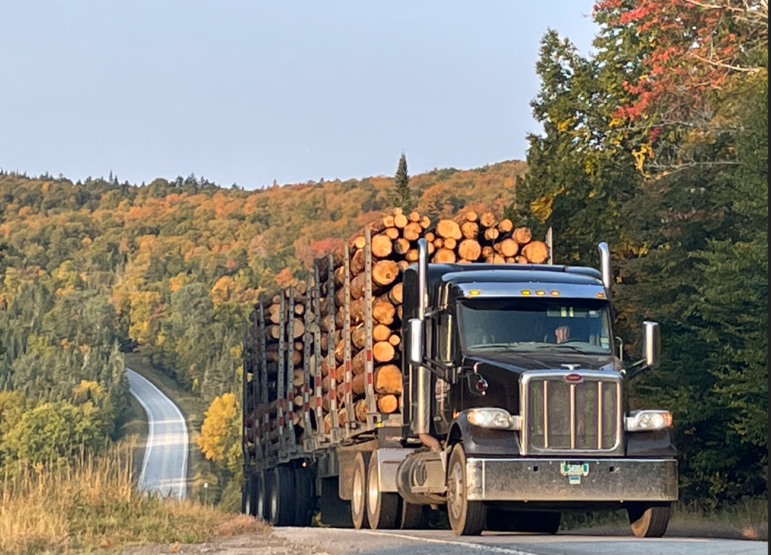
Above, Logging truck heads for the Canadian border at the intersection of the Connecticut Lakes Headwaters tract and Route 3 in Pittsburg. Paula Tracy photo
IMPACTS TO THE CHANGE
There are human, cultural, local fiscal and wildlife impacts to this change which are still being considered as the change is coming. For Hall, the impacts are significant for his family and many in the area who also log.
He and his father hope to return to log the headwaters this winter to work in the same area, but in a more limited capacity.
Hall said he started working the Headwaters tract about a year ago and thereafter, soon learned that the change in ownership would lead to reduction in logging. The word rippled through the forest to the mills and stores and town halls and sent public officials searching for answers.
Steve Ellis of the Pittsburg Selectboard said about 10 percent of the town’s budget comes from the tract, which has paid almost $200,000 a year in timber tax. Even a 50 percent reduction is going to leave the town searching to either increase taxes or reduce services.
“We don’t want to do either,” he said.
Ellis said many residents like Eric Hall are going to be impacted particularly with the loss in work and a potential increase in taxes or loss of services.
Hall said another family member has been able to truck the wood to mills in Canada, New Hampshire, Maine and Vermont which in some cases say they are starving for wood to process as nationally, mills are closing.
Milan Lumber, which had been processing softwood from the tract for years, went to a furlough period for a month and officials there as well as local Ethan Allen hardwood mill in Beecher Falls, Vt. are now searching as far as New York state for wood.
Now Hall said he has to go far away to find logs to cut and he worries about the future not only for him but the forest and the culture of the region.
He is now traveling to Vermont to cut trees and he could not attend the Wednesday meeting because he needed to be in the woods, cutting trees.
“It is really a shame. This forest needs to be harvested and it can be used to sell carbon at the same time,” he said.
Looking at other properties owned by BSFC across the nation, he noted that this forest is more productive as a timber forest than as a carbon credit farm.
“It’s old. A lot is falling down. It’s a short growing season. The elevation is high. It’s not really what they are after,” he said.
The state has a right of first refusal on the tract and if they could exercise that, it would be most beneficial, he said.
FIRST TIME FOR BSFC AT THE MEETING
For the first time, officials for Bluesource Sustainable Forest Company addressed the Connecticut Lakes Headwaters Citizens Committee, Wednesday at the headquarters for the Pittsburg Ridge Runners.
Blake Stansell, president of Bluesource Sustainable Forest Company, confirmed what the rumor had been that harvest on the tract will be reduced by roughly 50 percent going forward.
Right now, he said, the company is working to finalize the harvest budget going forward, and then meet with the state to discuss the easement and its requirements.
Shawn Hagan, BSFC’s New Hampshire land manager, said the short term plan will be completed in the next few weeks with a sale or two pending on Perry Stream Road with a total of four sales in the works right now for the winter.
Patrick Hackley, director of the NH Division of Forest and Lands, said the easement is fairly broad but the BSFC’s management plan is to be revised and weighed against the easement’s goals.
The attorney general’s office will be reviewing the revised plan when it is received, said Sarah Stewart, commissioner of the Department of Natural and Cultural Resources who attended the Wednesday meeting.
ROADS IN NEED OF WORK
The state owns more than 200 miles of roads on the tract and generates revenue from logging operations, which will be curtailed by the loss of logging.
There is also an endowment for the road care, with the balance going down faster than it earns on the market and the deterioration over the past 20 years from both logging and recreation has been significant. It was a particularly rough summer due to rains.
The state has appropriated $1.5 million in the capital budget going forward to work on the roads but members of the advisory committee urged a long-term plan to address needs, based on public input.
The state is looking to crush about 62,700 yard of gravel from the Smith Brook and South Bay pits and resurface Perry Stream, Cedar Stream, Deadwater Loop, Smith Brook and Magalloway roads.
That is estimated to cost about $470,000 in Phase I. Phase II looks at spending $341,000 and using gravel from pits on Smith Brook, Indian Stream to cover Garfield Falls, Tower Road, Hall Stream, East Inlet and Boundary Pond Roads.
COMMITMENT FROM BSFC
Stansell said the company wanted to emphasize three points.
“We are committed to managing the land in the spirit and letter of the conservation easement,” Stansell said. “We want to work with Pittsburg to address the shortfall in funds with a loss of timber tax funds, and we are committed to enhancing recreation opportunities.”
While primary recreation uses for the land in the easement have been snowmobiling, logging and hunting, secondary uses for ATVs, camping, extended hiking and backcountry ski trails, equestrian and special use permits are being explored by the committee.
A recreation plan has to be approved by both the state and BSFC.
So far BSFC is not willing to expand use by ATVs on the property, both Levesque and Hagan confirmed.
The forest aspect is still an important part of the ownership, Stansell stressed, but it is not mutually exclusive to carbon markets.
He explained the carbon market has a financial instrument that represents one metric ton of carbon which has either been avoided from release or removed. It needs to be verified, enforceable and permanent.
In a forest project you basically look at the amount of carbon you have stored at a given time and how much you have after one year. That represents the credit. There is no credit for dead trees or underground roots.
“Timber harvesting is a complementary part of the process and is expected,” Stansell said.
“When we enroll into a project we are committed to maintaining stocks,” and can on an annual basis cut or add to the carbon stocks.
“Our investors look at it as a value added…exposure to two commodities and the protocols do have an expectation that they will remain a working forest for the long term,” he said.
“We are going to continue to practice silviculture,” or growing and cultivating trees. With a long term in mind, and the fact there are two sources of revenue allows for the diversity.. and we are able to do more work on the front end to ensure harvest practices are correct,” he concluded.
Hagan, who is BSFC’s local land manager, addressed the committee on cutting wildlife management opportunities to enhance certain species. Young forests are typically good forests for game, he noted.
“We want to look closely at cuts on the forest that enhance water quality and trail, including the transportation of wood products,” Hagan said.
